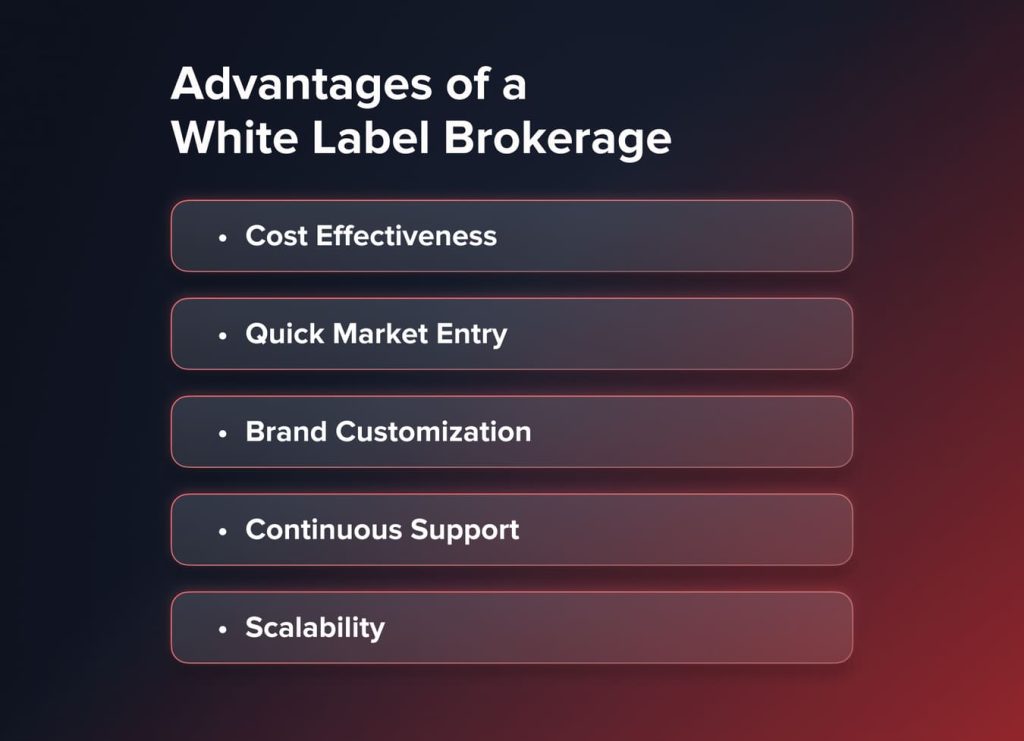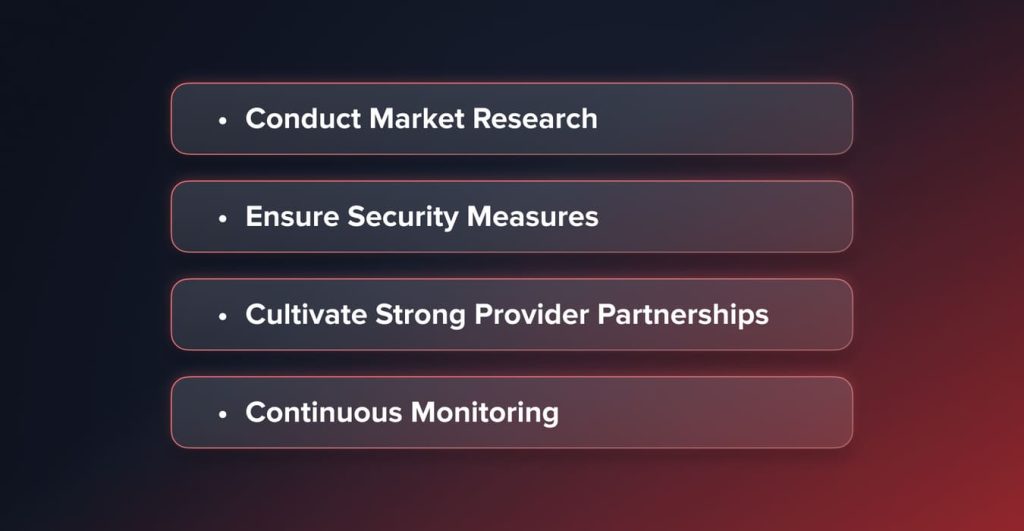
O que é uma corretora White Label e como ela funciona?
Conteúdo
No mundo financeiro dinâmico de hoje, a capacidade de inovar e se adaptar é fundamental para a sobrevivência e o sucesso de uma empresa. O conceito de corretora white label vem ganhando força nos últimos anos por sua capacidade de nivelar o mercado. Embora não seja novidade, esse conceito está causando um grande impacto no setor financeiro e de corretagem. Vamos analisar o que é uma corretora white label, como funciona e quais benefícios ela oferece.
O que é uma corretora White Label?
O termo "white label" vem da indústria musical. Os discos de vinil eram enviados às rádios em capas brancas simples, sem marca. Com o passar do tempo, esse conceito foi adotado por diversos setores, incluindo o financeiro.
Em termos simples, um produto de marca branca nada mais é do que um contrato de licenciamento. A corretora basicamente compra um produto completo, isento de qualquer marca, o marca de acordo e o revende como se fosse seu próprio produto. Para uma corretora, isso significa que ela recebe uma plataforma totalmente funcional, altera a aparência e as funcionalidades para atender às necessidades de seu público-alvo e a apresenta ao mercado como sua própria plataforma de negociação.
Agora que temos uma melhor compreensão do que é um Plataforma WL ou seja, vamos dar uma olhada mais de perto e nos benefícios oferecidos.
Vantagens de uma corretora de marca branca
A evolução e a demanda das corretoras WL não aconteceram por acaso. Uma ampla gama de benefícios serviu de catalisador para a adoção em massa dos produtos WL.

Custo-efetividade
Começar uma corretora do zero é uma tarefa imensa, que exige que você equilibre diversos fatores. Isso inclui lidar com problemas de software, tecnologia necessária e confiável, contratar profissionais qualificados e confiáveis, além de lidar com um labirinto de regulamentações e leis, dependendo do país. Todos esses fatores exercem uma pressão enorme sobre o bolso do empresário, levando a custos de entrada inflacionados. Como resultado, muitos potenciais participantes são dissuadidos pelos custos proibitivos. A plataforma white label alivia consideravelmente o fardo financeiro ao iniciar uma corretora. O melhor é que você só paga pelo que precisa: a empresa consegue obter um produto perfeitamente adequado à sua escala atual e trajetória futura. Assim, as empresas conseguem lucrar centenas de milhares de dólares durante os estágios iniciais cruciais.
Entrada rápida no mercado
Para corretoras no mundo das finanças, tempo é muito mais do que apenas dinheiro – é oportunidade. Qualquer atraso no estabelecimento da sua presença e a corretora não só perde dinheiro, como também perde terreno para a concorrência. Utilizar uma corretora white label, com sua plataforma totalmente funcional, permite que potenciais empresários entrem no mercado rapidamente. E, em vez de desperdiçar tempo e dinheiro nas etapas iniciais de lançamento, as empresas podem direcionar esses recursos para marketing e aquisição de clientes.
Personalização da marca
O fato de o produto de marca branca ser oferecido como uma plataforma geral é outro benefício tangível para a corretora. Isso permite que a corretora personalize o produto. Desenvolver uma interface intuitiva e amigável, integrar ferramentas de negociação específicas para a clientela, diversos recursos educacionais adicionais e adicionar o logotipo e as cores da empresa – tudo isso está nas mãos da corretora. Com opções de personalização tão amplas, as corretoras conseguem se destacar da concorrência e cultivar a fidelidade do cliente, mesmo em um mercado saturado.
Suporte Contínuo
A tecnologia no setor financeiro está em constante evolução e aprimoramento. Embora isso seja necessário e positivo, apresenta uma série de desafios para os proprietários de corretoras. As empresas precisam se adaptar constantemente a regulamentações em constante mudança, novas e aprimoradas opções de software, novas ameaças à segurança, novas ferramentas de negociação e a lista continua. Isso representa um pesado ônus para a corretora, pois uma grande força de trabalho é necessária para acompanhar todos os desenvolvimentos. Aqueles que optam por uma solução WL contam com a segurança das equipes de suporte dedicadas do provedor. O objetivo dessas equipes de suporte é garantir que a plataforma esteja sempre atualizada e em conformidade com os requisitos regulatórios. Elas também garantem segurança e proteção, essenciais em finanças.
Escalabilidade
O crescimento dos negócios é uma parte necessária e crucial da evolução natural de uma empresa. Isso inclui expansão, diversificação e, às vezes, até mesmo consolidação ou rebaixamento. A vantagem de usar uma plataforma WL é que ela foi projetada com isso em mente e pode lidar perfeitamente com o estresse da escalabilidade. À medida que a corretora cresce e lida com o aumento da clientela, do volume de negociação e das classes de ativos, a plataforma WL está equipada para lidar com as mudanças necessárias sem grandes períodos de inatividade. Isso significa que os fundos não precisam ser dedicados a longas atualizações ou revisões de infraestrutura. O produto WL é capaz de crescer e evoluir junto com as necessidades individuais da empresa, simplificando o processo natural de crescimento.
Apesar dos inúmeros benefícios que o Provedor WL ofertas, as corretoras precisam considerar alguns dos potenciais desafios. Eles são discutidos a seguir.
Desafios potenciais
Embora a tentação seja focar apenas nos benefícios e vantagens que o produto WL oferece, é necessário ter uma visão holística do produto. Portanto, os desafios também devem ser discutidos abertamente.
Risco de Dependência
Apesar de todos os recursos e funcionalidades oferecidos pela solução WL, a corretora nunca é a proprietária real da plataforma. Assim, um terceiro está sempre presente, o que significa que, mesmo quando personalizado de acordo com as suas necessidades, o provedor externo permanece o proprietário. Caso esse terceiro encontre problemas, isso afetará diretamente a sua corretora. Fatores como paralisações inesperadas, falhas e manutenção podem ter sérias consequências para a sua corretora. Uma corretora pode se ver lidando com problemas e preocupações dos clientes sobre os quais não tem controle.
You may also like

Diferenciação Limitada
O produto WL pode ser personalizado de acordo com as necessidades da corretora, mas é importante lembrar que as opções não são ilimitadas. Em algum momento, as limitações se tornarão óbvias. Como uma corretora pode se destacar em um mercado concorrido quando muitos concorrentes utilizam a mesma plataforma, sendo a personalização da marca o fator diferencial?
Estrutura de custos
Um dos principais benefícios de um produto WL também pode ser uma faca de dois gumes. Como discutido acima, a solução WL oferece uma maneira excelente e econômica de lançar uma corretora. No entanto, à medida que a corretora se expande e as operações se tornam mais complexas, a estrutura de preços pode não ser tão tolerável para a corretora como costumava ser. Isso pode incluir um aumento nos custos transacionais, cobranças por recursos e funcionalidades adicionais ou segurança adicional.
Preocupações com a integração
Uma corretora não se resume apenas a transações e negociações, mas sim a um ecossistema vivo que depende de uma série de ferramentas e plataformas para prosperar. Indo além da simples parte transacional da corretora, um sistema de CRM, um painel, análises e relatórios desempenham um papel importante na garantia da sobrevivência e do crescimento da plataforma. Portanto, a integração de outras ferramentas deve ser rápida e eficiente. Quaisquer dificuldades podem interromper o fluxo operacional, levando a problemas. Como tudo isso faz parte do relacionamento com o cliente, tudo deve funcionar perfeitamente e sem complicações. Caso contrário, a perda de clientes se tornará um problema real.
Agora que alguns dos principais benefícios e desafios foram discutidos, vamos explorar como uma empresa pode começar a trabalhar com um fornecedor de marca branca.
Parceria com um provedor de marca branca
Selecionar um provedor de WL certamente facilita o processo de abertura da sua própria corretora. No entanto, o planejamento ainda é necessário para que o processo ocorra sem problemas. Vamos explorar algumas das etapas necessárias.
Parceria com um Provedor
Sua primeira decisão importante a tomar é escolher um provedor. Como esta será uma aliança estratégica para os próximos anos, muitos fatores devem ser considerados. Considere mais do que apenas o custo do produto, mas o valor que sua corretora receberá em troca. Além disso, pesquise a reputação e o histórico do provedor e observe fatores como tempo de atividade do sistema, diversas equipes de suporte e atualizações de conformidade. Pesquise avaliações e depoimentos de clientes para ter uma ideia em primeira mão do que você receberá. Muitos consideram que provedores com tecnologias robustas e equipes de suporte 24 horas por dia, 7 dias por semana, são os aspectos mais cruciais de uma solução de WL.
Personalizando a plataforma
O próximo passo é o empolgante processo de personalização, no qual você moldará e criará uma plataforma que reflita sua marca e sua identidade única. Além das mudanças estéticas, você personalizará a interface do usuário e as ferramentas de negociação. Esse processo exigirá a colaboração tanto da sua equipe de design quanto da equipe técnica do provedor para garantir uma integração tranquila e perfeita.
Regulamentação e Conformidade
Dependendo do país de sua escolha, você precisará lidar com diversos órgãos reguladores, inúmeras leis e regulamentações. Um único passo em falso pode ter consequências desastrosas, desde multas até o fechamento total. Trabalhar em estreita colaboração com as equipes jurídicas garante que você possa evitar esses desastres e permanecer totalmente operacional. Isso significa garantir que você tenha as licenças necessárias para operar uma corretora na jurisdição atual.
Marketing e Aquisição de Clientes
Agora que a plataforma está personalizada, em conformidade com todas as regulamentações e pronta para uso, o objetivo é direcionar o máximo de tráfego possível para ela. Um marketing eficaz é a chave para conquistar uma grande base de clientes. No entanto, não existe uma "maneira única" de fazer marketing. Um marketing eficaz inclui campanhas de marketing digital, diversas parcerias, publicações e canais educacionais. Ter uma visão clara do seu público-alvo ajudará você a criar a campanha de marketing mais eficaz para sua corretora.
Operação e Manutenção
Um dos maiores fatores para construir uma reputação sólida e confiável para uma corretora é sua eficiência operacional. Isso significa que sua plataforma é capaz de lidar com os diversos aspectos operacionais, como execuções de negociações, gestão de riscos e atendimento ao cliente: garanta que suas equipes de suporte estejam disponíveis e bem treinadas para fazer exatamente isso. Revise e realize testes de estresse periódicos em sua plataforma para identificar e eliminar quaisquer bugs ou deficiências. Se você tiver escolhido um bom provedor, muitas vezes suas equipes de suporte também poderão ajudá-lo com essas tarefas.
Ter um plano não é suficiente; o sucesso de uma corretora de marca branca depende da execução e da adesão às melhores práticas do setor, que exploraremos na seção a seguir.
You may also like

Melhores Práticas
Vamos falar sobre algumas práticas recomendadas para organizações que buscam deixar sua marca no setor de corretagem de marca branca.

Realizar pesquisa de mercado
Para ter sucesso, você precisa primeiro entender o cenário em que sua corretora atuará. Portanto, a pesquisa de mercado é vital antes de realmente se lançar e lançar a corretora. Isso inclui estudar potenciais concorrentes, pesquisar a composição demográfica e psicográfica da clientela-alvo e identificar e reconhecer as lacunas no mercado e as melhores maneiras de preenchê-las. Além disso, uma pesquisa de mercado abrangente permite que você encontre pontos problemáticos específicos, bem como os desejos e anseios do cliente em uma plataforma, e então atenda a essas necessidades específicas, proporcionando a você uma vantagem competitiva.
Garantir medidas de segurança
Na era digital atual, em que tantas informações pessoais são armazenadas online, uma violação de dados ou um ataque cibernético é um desastre absoluto. Como a corretora WL terá acesso às informações pessoais sensíveis do cliente, além de lidar com grandes transações financeiras, a segurança deve ser uma prioridade máxima. Certifique-se de que a corretora utilize autenticação multifator, as técnicas de criptografia mais recentes e avançadas e realize auditorias de segurança frequentes. Cuidar da segurança também inclui o lado do cliente: educar os clientes sobre as melhores práticas de segurança aprimorará e fortalecerá a infraestrutura geral de segurança.
Cultive parcerias fortes com provedores
Como discutido acima, uma plataforma WL não é um projeto independente, mas sim parte de um ecossistema. É vital desenvolver bons relacionamentos de trabalho com diversos parceiros. Um aspecto importante é desenvolver e manter canais de comunicação abertos para garantir que quaisquer problemas, novidades ou atualizações sejam resolvidos imediatamente. Como o relacionamento é para o benefício de todas as partes, é do interesse de todos que a plataforma funcione bem. Comunicar-se regularmente e organizar sessões de check-in e feedback pode ajudar todos a alcançarem o sucesso.
Monitoramento Contínuo
Devido à constante evolução do mundo das finanças, bem como à velocidade com que novas tecnologias estão sendo desenvolvidas, é vital continuar a melhorar e a aprimorar-se, sem se acomodar. O monitoramento contínuo do desempenho da plataforma é necessário para alcançar os melhores resultados. Além disso, buscar ativamente o feedback dos clientes pode ser de grande ajuda ao tentar aprimorar a plataforma. Ouvir o feedback do cliente e levar em consideração seus desejos ao atualizar e integrar novas funcionalidades levará ao aumento da satisfação e da fidelidade do cliente, além de ajudar a corretora a se manter eficiente e à frente da concorrência.
Conclusão
O modelo de marca branca mudou o panorama do mundo financeiro. Graças à sua rápida entrada no mercado, sem os custos iniciais exorbitantes e as dificuldades de construir uma plataforma personalizada do zero, uma solução WL permite mais oportunidades para lançar uma corretora. À medida que os mercados continuam a evoluir, utilizar o produto WL ao máximo será fundamental para aqueles que desejam ter sucesso e se manter no topo.
Atualizado:
19 de dezembro de 2024



